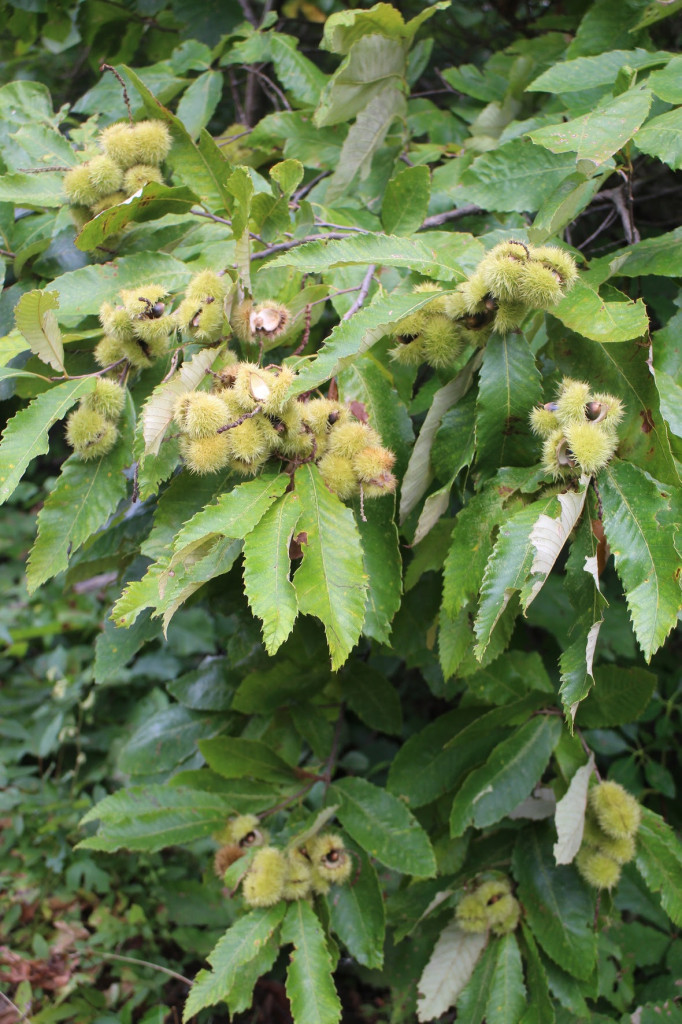LISA BRIGHT SHARES HER GARDEN FAVES
CHOOSING THE RIGHT NATIVE PLANTS FOR YOUR GARDEN
Lisa Bright, Executive Director and Co-Founder of Earth Sangha in Springfield, Virginia, shares some of her favorite native plants for gardeners in the DMV. Seeds are collected in the wild, propagated and the plants are returned to natural areas for restoration purposes. We are fortunate that these plants are also offered to the public. Take advantage of this wonderful resource and introduce some life-supporting and uncommon plants to your gardens today.

Photo courtesy Earth Sangha.
Alleheny Chinkapin (Castanea pumila): This is the first time we are able to offer this lovely species. It is extremely hard to find Chinkapin with its chestnut-like nuts in our region because of habitat loss, and it won’t be available every year. It is fairly quick growing once established. We decided to distribute it this fall because it’s better that the seedlings be planted in the ground now than to sit in pots at our nursery during the winter.
Common Elderberry (Sambucus canadensis): In moist open areas or at the edge of pond or stream, this multi-stemmed shrub will produce beautiful flowers and abundant fruits for birds. It acts like a salad bar for birds. You can also make jams out of fruits. This shrub would love to stand in water as well but also works well in ordinary soil. You can easily tame/control them by cutting the stems. It won’t hurt them.
Whorled Rosin Weed (Silphium asteriscus var. trifoliatum): If you like Cup Plant (Silphium perfoliatum) which is not native, you will love this plant. It is 4 to 6 feet tall and upright and produces pale yellow flowers in summer. You see them in moist open meadows in Manassas, Centerville, or other power line meadow sites.
Broadleaf Ironweed (Vernonia glauca): It looks a lot like New York Ironweed except that it grows in open meadows. It attracts lots of butterflies and other beneficial insects.
Slender Bush Clover (Lespedeza virginica) & Hairy Bush Clover (Lespedeza hirta): To me, this is a must plant for open meadow. They offer important nectar as well as seed sources for birds and others. Lespedeza is largely overlooked by gardeners.
Tick-trefoil (Desmodium spp.: D. paniculatum, D. ciliare, D. marilandicum): I’m a big fan of all Desmodium species. Their intricate purple flowers attract lots of insects. They fix nitrogen in soil. They grow in open meadows and on sandy or rocky banks.
Downy Blue Lobelia (Lobelia puberula): You will find this elegant Lobelia more in the coastal region. I spotted at least two great habitats. They grow on moist sunny and sandy banks in groups. Their blue flowers begin in mid summer with its peak in September. It attracts lots of butterflies and bees.
Narrow-leaved Mountain Mint (Pycnanthemum tenuifolium): If you cannot find this species in local meadows, it is not quite a fully matured meadow yet. The small white flowers cluster together at top. It attracts lots of pollinators, of course.
Roundleaf Thoroughwort (Eupatorium rotundifolium): Its presence indicates a healthy meadow.
Beaked Panic Grass (Coleataenia anceps): This grass is easy to grow and care for, and it offers abundant seeds. It grows in moist open meadows. If you think Indian Grass is too tall to handle, this grass will do.
Redtop or Dense Panic Grass (Coleataenia rigidula): It looks ornamental with its lovely and generous red plumes. It is about 1 to 3 feet tall and forms a pleasing bunch. It loves wet and looks lovely along pond or stream edges.
Lurid Sedge (Carex lurida): This sedge is very versatile and yet it is woefully underused. It can form nice weeping grassy banks even on dry sites near streams. Once established, it is virtually carefree.
Deertongue Grass (Dichanthelium clandestinum): If you look at any healthy woodland, its moist edges are packed with this grass species. It keeps the soil moist and prevents invasive plants from entering the woodland. It also feeds lots of insects and birds. What more would you ask from a hard-working plant?
Silverrod (Solidago bicolor): It is the only white-flowering Goldenrod! It looks exactly like Erect Goldenrod (Solidago erecta) except that its petals are white! Its habitat is partially shaded woodland.
Crooked-stem Aster (Symphyotrichum prenanthoides): It took me several years to finally locate this species in the wild. It grows right along streams in shade. It also grows in drier and more open areas. It has lovely blue blooms in summer to fall.
Smooth Aster (Symphyotrichum laeve): This species of aster blooms quite late in the season. It grows on rocky banks or such rough sites. It has such an easy grace.
Pasture Thistle (Cirsium pumilum): Unlike Field Thistle (Cirsium discolor), the growth habit of this species is less assertive. It grows up to 3 ft. only and attracts all sorts of butterflies. It won’t overwhelm your small garden! It’s biennial.
Hollow-stemmed Joe Pye Weed (Eutrochium fistulosum): We want you to plant this lovely species all over the area. It used to be everywhere in wet areas, on shaded banks, and at the edge of the woodland. But we are losing them. We are also losing them to non-native species of Joe Pye Weed.
Maryland Golden Aster (Chrysopsis mariana): If you have sunny, dry, and poor soil conditions and don’t know what to do? Maryland Golden Aster loves that kind of spot. It used to be abundant but we are losing them now. Please use more of this lovely carefree plant.
Grey Goldenrod (Solidago nemoralis): Again, this species of Goldenrod (short, 1 to 2 ft only) loves sunny, dry, and poor soil. There should be a lot more of this species along the roads or abandoned areas.
Wild Basil (Clinopodium vulgare): On moist meadows near streams or edge-of-the woodland, you will find this enchanting mound of aromatic plant. It is low growing. A lovely form to behold.
Little Bluestem (Schizachyrium scoparium): This grass is a healer of ground. If you are making a fresh new meadow from scratch, please you must use this grass first. There are certain basic soil-building native species that would work as healers. This is one of them.

a favorite seed source.
We are also offering Eastern Prickly Pear (Opuntia humifusa) and Wild Stonecrop (Sedum ternatum).
We offer these plants and many, many more. See you at the nursery!
Lisa Bright, Co-founder
www.earthsangha.org
You can become an Earth Sangha member and also sign up for Lisa’s future newsletters at earthsangha.org.
